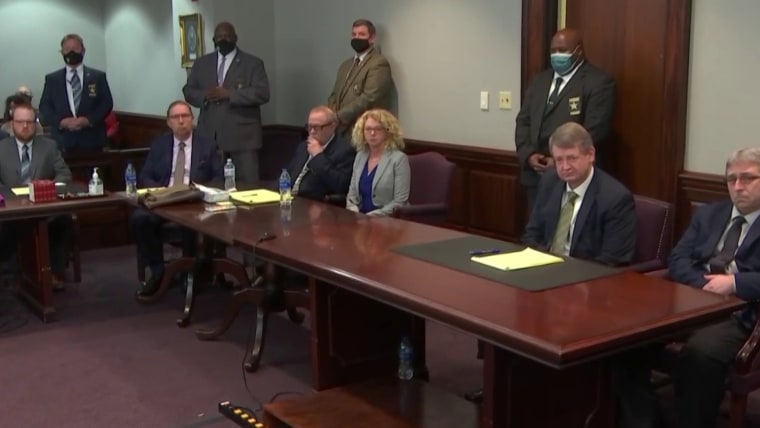Legal experts say they’re not surprised that guilty verdicts for felony murder and other charges were reached by a Georgia jury Wednesday against the three white men on trial in the shooting death of Ahmaud Arbery, a Black man whom they had chased through their neighborhood last year.
But Travis McMichael, 35, the man wielding the shotgun and who pulled the trigger, was found guilty of an additional charge — malice murder — whereas his co-defendants, his father, Gregory McMichael, 65, and neighbor, William “Roddie” Bryan, 52, were not.
Page Pate, a Georgia defense attorney who is not affiliated with the case, said the jury’s finding makes sense.
Malice murder, he said, is akin to a first-degree murder charge in other states. According to Georgia law, it means someone had a “deliberate intention unlawfully to take the life of another human being” where they weren’t provoked and demonstrated “an abandoned and malignant heart” — or essentially, it was done out of ill will.
The prosecution was able to successfully argue that as the person who made the decision to fire the weapon, Travis McMichael was malicious in a charge that carries a life sentence. They also made clear that malice murder can be committed in a split second, and leaned into the idea that Travis McMichael grew angry when Arbery didn’t heed his commands to stop during the encounter.
In addition, all three defendants were found guilty of various counts of felony murder, a charge typically given to someone who was an accomplice in a person’s death but didn’t physically kill.
Both the McMichaels and Bryan had pursued Arbery, 25, in pickup trucks before the confrontation turned fatal. Bryan also recorded the encounter on his cellphone.
Defense attorneys said the McMichaels chased Arbery because they suspected he was a burglar who had been recorded on video inside a house under construction nearby. They say Travis McMichael feared for his life when he shot Arbery as they grappled over a shotgun.
Prosecutors and Arbery’s family members have said he was an avid jogger who had been running through the Satilla Shores neighborhood.
The defendants argued self-defense, as well as acting within their rights under Georgia’s citizen’s arrest law, which was legal at the time but later changed in the wake of the shooting.
Bryan was found not guilty of one of the counts of felony murder, as well as a count of aggravated assault. During closing arguments, his attorney, Kevin Gough, tried to distance him from the actions of the father and son, telling the jury that his “presence is absolutely superfluous and irrelevant to the tragic death of Ahmaud Arbery,” and that it was Bryan’s decision to record the final moments of Arbery’s life that turned into a pivotal piece of evidence in the case.
Given the jury’s verdict, all three defendants face minimum sentences of life in prison.
The fact that jurors did not come to a guilty or not guilty finding across the board for all three men shows how meticulous they were in considering each count, Pate said.
The beginning of the trial had also drawn scrutiny when a jury was seated of 11 white people and one Black person in a jurisdiction, Glynn County, where nearly 27 percent of the population is Black. Family members of Arbery had worried that the lack of racial diversity could have an ill effect on the proceedings.
But Pate said the unanimous guilty verdicts indicate that wasn’t the case.
“An almost all-white jury found these white defendants guilty of murder,” he said. “It’s a good sign for our community and our country, and I think it says we support self-defense and the Second Amendment in the rural South, but when it’s upheld correctly.”
The lawyers in the case largely left race out of the trial.
With self-defense at the crux of the defendants’ case, the onus was on prosecutors to disprove the defense’s argument beyond a reasonable doubt, which can be an uphill battle in general, said Mike Lawlor, a former prosecutor in Connecticut and an associate professor of criminal justice at the University of New Haven.
But Lawlor said the video evidence clearly helped to frame the prosecution’s narrative that it was Arbery, not the defendants, who was running for his life and then fought back in his final moments.
The defense “tried to color it that Arbery had prior encounters with the law and walked in a house that was under construction, somehow deserving what happened to him,” he added. “They tried their best to influence the jurors’ perception, but at the end of the day the sequence of events couldn’t be challenged. There wasn’t a lot to dispute.”
The outcome of the trial in Georgia runs counter to another high-profile self-defense case that was unfolding at the same time involving Illinois teenager Kyle Rittenhouse.
A jury found Rittenhouse, who is white, not guilty in the fatal shooting of two men and wounding of a third, all white men, during a night of protests in Kenosha, Wisconsin, last year.
While there was also video evidence in Rittenhouse’s case, the prosecution was unable to convince the jury that he was a “wannabe soldier” who did not have to open fire. But Rittenhouse testified that he feared for his life when one of the men chased him and went to grab for his gun, which prompted Rittenhouse to kill him. Then, another man separately hit Rittenhouse with a skateboard, which the teen said led him to use his weapon again. Finally, a third man approached Rittenhouse with a pistol in his hand, and Rittenhouse shot him. That man was injured but survived.
The verdict in the politicized case sparked outrage from some who agreed with prosecutors’ comparisons of Rittenhouse as a vigilante.
While the fear among anti-gun violence groups and gun control advocates is that last week’s verdict in Wisconsin may prop up people who believe they can arm themselves and take the law into their own hands with impunity, the decision in Georgia may help tamp down that idea of “vigilante justice,” Lawlor said.
“If the verdict had gone the other way, you might ask, in our society, are we greenlighting this kind of behavior?” he said. “However, I hope this verdict helps reinforce that people ought to fully understand what you can and can’t do with a gun.”
Source: | This article originally belongs to Nbcnews.com










